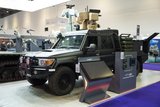Northrop Grumman delivers first battery engagement operations center for Integrated Air and Missile Defense Battle Command system
Northrop Grumman Corporation has delivered the first battery engagement operations center for the Integrated Air and Missile Defense (IAMD) Battle Command System (IBCS) to the US Army. The milestone was celebrated during a ceremony on Aug. 11 at the company's Madison facility on Wall Triana Highway.
When fully developed, the IBCS battery engagement operations center will enable an Army air defense battery to establish common battle command of air defense assets that are fully integrated with other Army and joint IAMD systems. The initial system consists of common hardware and software housed in a rigid wall shelter and mounted on a five-ton M1085 Medium Tactical Vehicle, a part of the Family of Medium Tactical Vehicles.
Highlighting the event were remarks by the US Army/industry IBCS team that included US Army Major General Genaro "Gino" J. Dellarocco, Program Executive Officer, Missiles and Space, Redstone Arsenal, Ala., and Karen Williams, vice president of Air and Missile Defense Systems for Northrop Grumman's Information Systems sector. The event also included remarks by US Army Brigadier General Roger Mathews, Commandant, Air Defense Artillery Center, Fort Sill, Okla.
"This initial system will be used as a test bed to support the IBCS critical design review and the IBCS software development and coding," said Dellarocco. "This prototype will allow the warfighter to interact early and influence the design to ensure we provide them this critical capability.
"We are nine months into this phase of the program and now have an IBCS engagement operations center, which is incredible. We have had several Army, Navy, Air Force, Missile Defense Agency and OSD (Office of the Secretary of Defense) leaders visit the Northrop Grumman IBCS development and integration laboratory. They will now be able to see and touch the actual IBCS system.
"I appreciate the great support the IAMD program is receiving from the Fires Center of Excellence, the 32nd Army Air and Missile Defense Command, the 11th Air Defense Artillery Brigade Headquarters, and the 5th Battalion, 52nd Air Defense Artillery," added Dellarocco.
"We leveraged the proven design from our Command Post Platform program to accelerate the first system delivery to the Army," said Williams. "Northrop Grumman reaffirms our commitment to provide our warfighters the absolute best solutions our company and many others have to achieve the warfighter's desire in closing the significant capability gap in air defense battle command. With our combined efforts, we are proud to be part of a government/industry team to provide our warfighters the tools to deliver the right information - at the right time and to the right place - in order to save lives during crucial, often very short, decision timelines."
In December 2009, the Northrop Grumman team was awarded a $577 million, five-year contract for the development of a common battle command system for Army integrated air and missile defense. The IBCS program will provide the Army with its first truly open-architecture and mission-tailorable battle command system for air and missile defense units. The system will also utilize an integrated fire control network based on a track management solution that provides vastly improved decision-making aids. This will enable IBCS to supply warfighters with the data to make time-sensitive tactical decisions under the most demanding conditions and significantly enhance joint IAMD operations.
Systems that will be integrated via IBCS include Patriot, Surface-Launched Advanced Medium Range Air-to-Air Missile (SLAMRAAM), Joint Land Attack Cruise Missile Defense Elevated Netted Sensor (JLENS), Improved Sentinel radar, and - if the US Department of Defense directs the inclusion - Terminal High Altitude Area Defense (THAAD) and Medium Extended Air Defense System (MEADS).
Source: Northrop Grumman
More from Digital Battlespace
-
![Babcock nears first customer for Nomad AI translation tool]()
Babcock nears first customer for Nomad AI translation tool
Nomad can provide militaries with real-time intelligence, saving critical time on the battlefield.
-
![AUSA 2025: Israel’s Asio Technologies to supply hundreds of improved Taurus tactical systems]()
AUSA 2025: Israel’s Asio Technologies to supply hundreds of improved Taurus tactical systems
Taurus operates alongside the Israel Defense Forces’ Orion system which supports mission management across tens of thousands of manoeuvring forces, from squad leaders to battalion commanders.
-
![AUSA 2025: Kopin pushes micro-LED plans as China moves faster]()
AUSA 2025: Kopin pushes micro-LED plans as China moves faster
The plan for the new displays follows fresh investment in Kopin’s European facilities by Theon and an order for head-up displays in fielded aircraft, with funding from the US Department of Defense.
-
![AUSA 2025: Persistent Systems to complete its largest order by year’s end]()
AUSA 2025: Persistent Systems to complete its largest order by year’s end
Persistent Systems received its largest ever single order for its MPU5 devices and other systems earlier this month and has already delivered the 50 units to the US Army’s 4th Infantry Division.
-
![Aselsan brings in dozens of companies and systems under the Steel Dome umbrella]()
Aselsan brings in dozens of companies and systems under the Steel Dome umbrella
Turkey has joined the family of countries attempting to establish a multilayered air defence system with government approval in August 2024 for the effort landed by Aselsan. Dubbed Steel Dome, the programme joins Israel’s Iron Dome, the US Golden Dome, India’s Mission Sudarshan Chakra and South Korea’s low-altitude missile defence system.
-
![DSEI 2025: MARSS unveils new agnostic multidomain C4 system]()
DSEI 2025: MARSS unveils new agnostic multidomain C4 system
MARSS’ NiDAR system has been deployed using sensors from static platforms to provide detection and protection for static sights, such as critical infrastructure, ports and military bases.




























